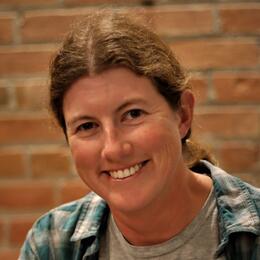Another entry in Abby’s Birdbrained Summer. Abby, the summer communication intern for the Coast Office of Audubon North Carolina, is visiting sites with Audubon’s field staff and our community of volunteers. After she goes into the field, she’ll post blogs detailing her experiences.
The Cape Fear River’s dredge islands are among the most important sites for nesting shorebirds in North Carolina. From April through August the islands are not open to the public because nesting birds are incredibly sensitive to human disturbance. Lindsay, Audubon North Carolina’s coastal biologist, visits them regularly to monitor the productivity of American Oystercatchers, but she also closely watches the numerous other bird species that use the islands as nurseries. I accompanied her to these islands on a breezy, overcast day. The river was choppy and I lost my hat, but Lindsay fished it out of the tea-colored water.
Ferry Slip Island was our first stop. Deposits of dredged sand formed the island, but the seven-acre area is not a barren desert island. Ample vegetation nearly covers the island now, making a preferred habitat for Laughing Gulls. Although Laughing Gull chicks are pretty adorable, their parents serve as a threat to other nesting birds. They have no qualms about snatching up an oystercatcher’s eggs, or even small hatchlings.
Lindsay slowly drove the boat around the island to see how the birds were behaving before we would disturb them by anchoring. Oystercatcher chicks normally hide in the vegetation when Lindsay sets foot on the island, but on the day we visited they weren’t shy. We got within fifty feet of Arnie, one of the birds equipped with a satellite transmitter as part of the American Oystercatcher Tracking Project. His chick, CF4, played in the water. Their play is practice for finding the shellfish they feed on. Unlike Arnie, CF4 has bright green bands around her legs. The color of CF4’s bands indicates that she was born in North Carolina; Arnie’s orange bands show that he is from New Jersey. If you want to keep up with Arnie, visit oystercatchertracking.org.
We walked through thousands of shrieking Laughing Gulls to see the colony of Brown Pelicans. I was impressed by their nesting behavior. The birds build large pods on the sand that stand a little over a foot tall, and their white eggs are about the size of my fist. One pelican helped his mate by bringing her nest material. Others fed their huge downy chicks. Their immature wings were startlingly like those found in a bucket of KFC. I was surprised that the little ones already had the saggy gular pouch.
The next island we visited was South Pelican Island. As we came downwind of the island, I was shocked by the smell. Thousands of birds make an unthinkable amount of feces. The dome of the island was completely covered in nesting Royal Terns and Sandwich Terns. I was surprised that the Royal Terns allow their yellow-tipped-beak relatives to nest within their expansive colony, but the behavior is common. Royals and Sandwiches often nest together. Lindsay is helping to collect eggshells for a UNCW graduate students' study that will determine if there is any mercury or other harmful chemicals present in their shells, but in order to do so, we had to get the birds off their nests. The noise the terns made when Lindsay stepped into their colony sounded like a battlefield. I was surprised to see that one of the Royal Terns had the ribbon from a balloon tangled in his tail feathers. Balloons released into the air seem harmless, but it is shocking to see the damage they can do when they ensnare a bird. Since the terns nest so closely, the ribbon could tangle around a number of birds and their chicks, and ultimately kill them. Unfortunately, we could not capture the bird to untangle the ribbon. It was sad to leave the bird behind, knowing the likely outcome.
I think it is interesting that some of the best habitats for nesting shorebirds are man-made islands. Although humans are a great threat to the birds’ productivity, somehow we managed to provide them with a home. Although the outcome was not planned, almost as soon as Ferry Slip and South Pelican Islands were created in the 1970s, the birds arrived. Just a few acres of dredged sand provide thousands of birds with a place to raise their offspring.
Sources:
http://www.capefearaudubon.org/documents/IBA_FerrySlipIsland.pdf




